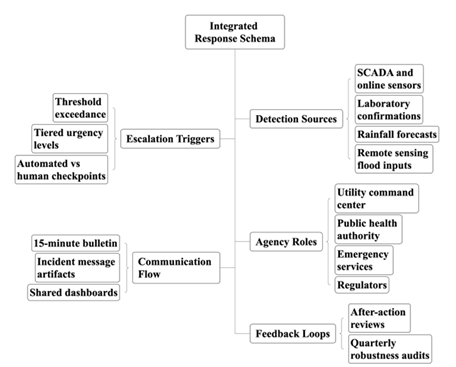Interagency Response Frameworks for Real Time Urban Water Quality Crises
Main Article Content
Abstract
This paper presents an integrated, operations-focused schema that links real-time urban water quality detection to tiered, interagency response. Urban systems face transient shocks and flood-driven contamination while detection platforms have advanced faster than coordination protocols, leaving triggers, roles, and outcomes weakly specified, especially for resource-constrained utilities. We synthesize existing protocols and incident taxonomies into standardized nodes, triggers, and message artifacts; fuse Supervisory Control and Data Acquisition (SCADA), online water-quality sensors, laboratory confirmations, hydraulic models, and Synthetic Aperture Radar (SAR)-optical flood mapping on Google Earth Engine (GEE); ingest probabilistic rainfall forecasts; and calibrate detectors using Root Mean Squared Error (RMSE), Mean Absolute Error (MAE), Nash-Sutcliffe Efficiency (NSE), and Percent bias. Evaluation reports detection-to-decision latency, trigger rates by type, and coordination indicators, with comparative tests against linear and threshold-only escalation quantifying speed-verification trade-offs under telemetry loss and staffing stress; quantitative gains are context dependent and subject to data coverage limits. The schema standardizes interoperable triggers, role assignments, minimal data fields, and 15-minute bulletin targets, and embeds after-action reviews and quarterly robustness audits to support adaptive learning.
Article Details

This work is licensed under a Creative Commons Attribution-ShareAlike 4.0 International License.

